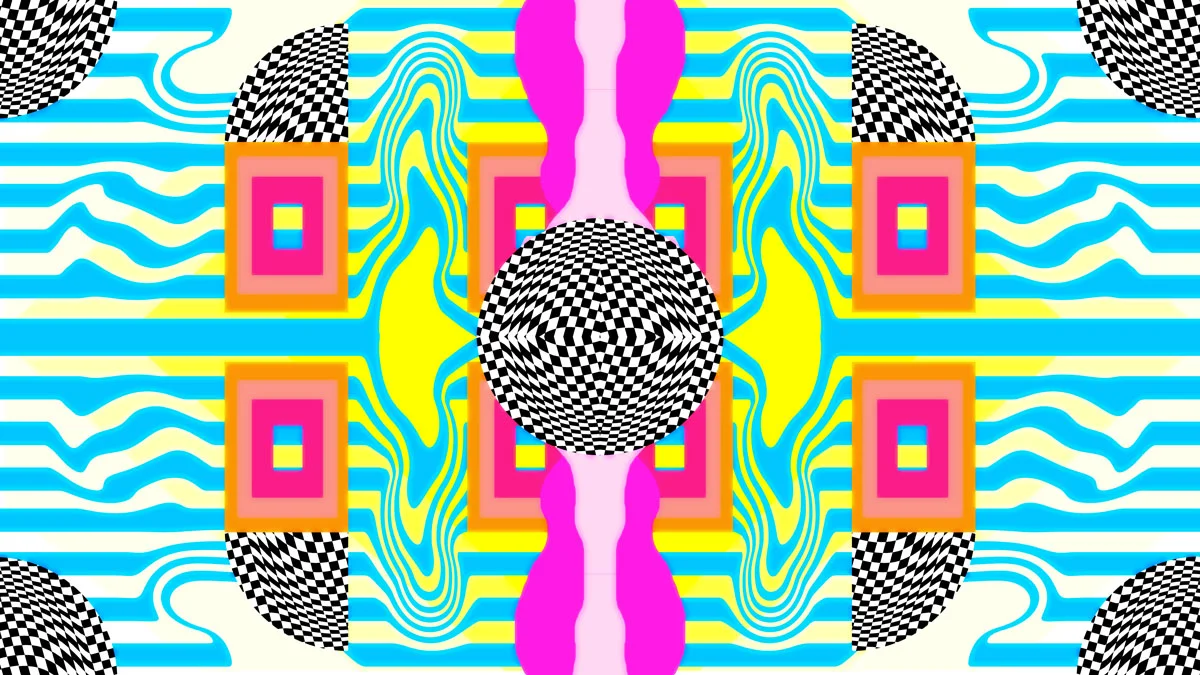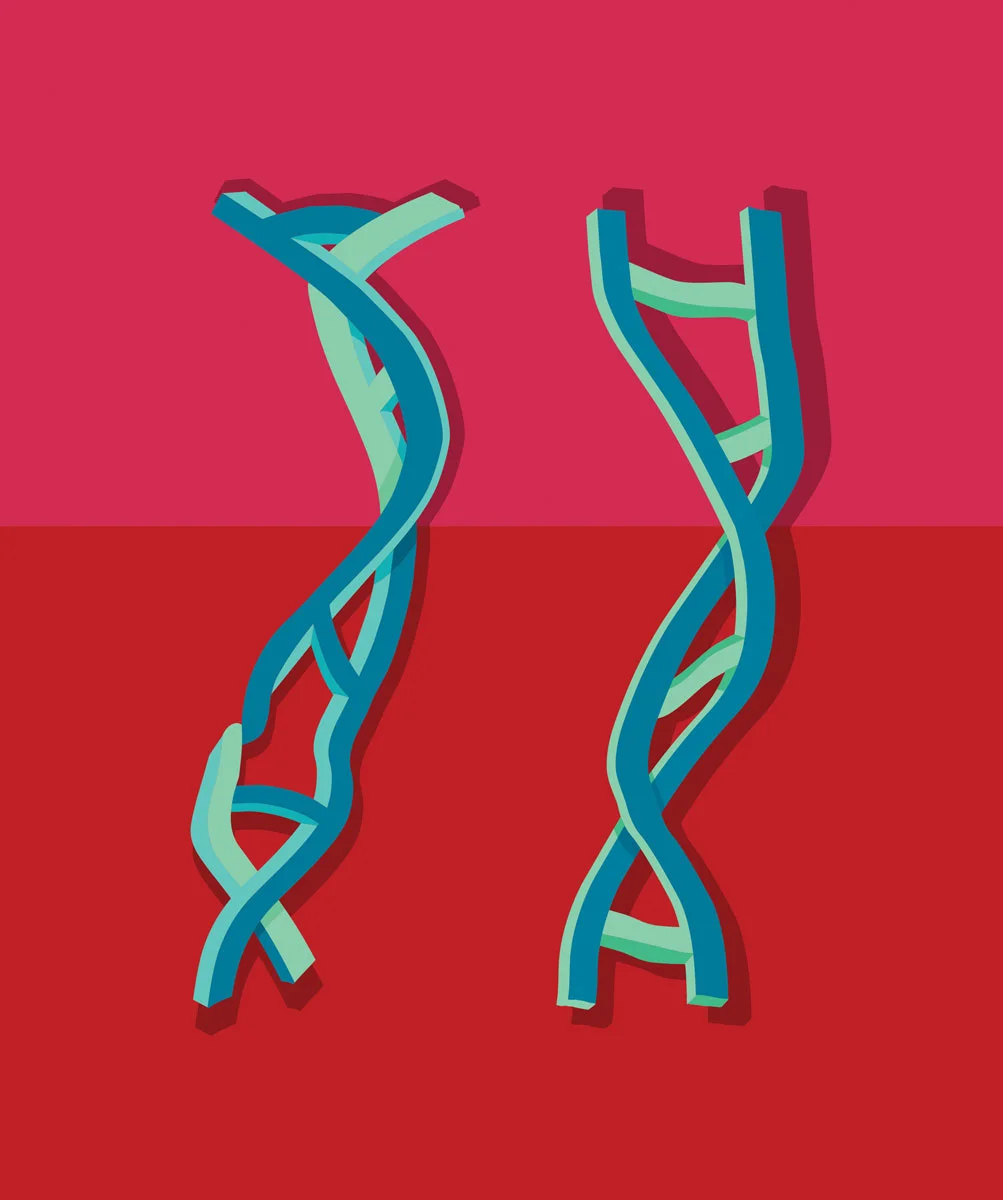
“Ace Video Painting 2,” (2013). QuickTime digital still. 1920 x 1080 pixels. Courtesy the artist.

“Concept Unification Painting,” (2010). Gouache on canvas. 5 x 7 feet. Courtesy the artist.

“Ace Video Painting 1,” (2013). QuickTime digital still. 1920 x 1080 pixels. Courtesy the artist.

“Ace Bendy Ladder 2 and 3,” (2013). Digital still. Courtesy the artist.
[](#)[](#)
Ben Jones
This Is Your Brain On Childhood
Ben Jones is an omnivore when it comes to media—working in painting, drawing, sculpture, animated television shows, music videos, zines, graphics, furniture and web design, interactive architectural spaces, and large-scale video installation. Famously mining childhood for imagery, iconic characters, dazzling neon color, paradoxical economies of scale, and a breezy surrealism, Jones also, in a way, re-creates it—not by depicting actual childhood, per se, but rather by creating a universe that is powered by childhood. His work is not nostalgic, it’s not cynical, and it’s not even really Pop; it’s about the sense of wonderment associated with how a child moves through a world that is still fresh and new to them and full of possibilities—and about strategies for keeping that wonderment alive no matter how hard life and art school try to kill it.
_When and why did you move to L.A.? Do you like it here?_ Kinda. Maybe a couple years ago. But every morning as I first open my eyes and see the beautiful L.A. light poke through the curtains, it’s like a honeymoon mixed with a dream mixed with a cyberpunk VR holodeck fantasy. I love it.
_Please discuss the fluid nature of how you move between disciplines. How do your artworks start life—as ideas or already as images, basic shapes of objects, full scenarios, pure color, or...?_ Everything is about the computer. The work I do starts as either experimental animation exercises, fucking around with Photoshop, or wasting weeks deep down a 3D-modeling hole. Ultimately it’s about discovering objects or experiences within a digital toolset. Like a colorist with piles of pigment, my work is a series of open applications constantly rendering and crashing my computer. When I was a kid, the second I got my hands on an Atari 800 I started drawing, doing logos, making music. I love it like a painter loves the smell of turpentine…which ultimately I imagine they grow to hate, but any deep co-dependent relationship has its intricate dynamics, and that’s where the good shit comes from.
_How does collaboration affect that? For example, your work as one-third of Paper Rad, or in designing furniture that needs to be functional, or music videos (like for MIA, for Beck), or interpreting show scripts which have someone else’s vision embedded. Do these external factors limit or inspire you?_ Great things—bridges, penicillin, David Lynch—are created by a team. No artist I know doesn’t want to be part of the best team, studio, band, or movement. Sonic Youth, Murakami, Warhol—all of these things boil down to dirty 20-year-olds on their knees making silkscreens. When I work with a team to make long-form narrative animation, or saw-cut wood, I feel like I’m playing with the Red Sox in the World Series.
_Please tell us more about your fascination with childhood, especially in terms of how your work brings that into adult life and art history._ Right now I’m storyboarding a sequence of an anthropomorphic duck-child named Bug running through her town listening to Philip Glass and hopping over homeless people, who in her mind are sleeping fur-dragons. Maybe I’m in too deep to talk about this with any perspective. \[Laughs\] I know I hate escapist art, or emo shit, but there is something awesome with this kid stuff. I try to be careful to harness the childhood worldview in a way that doesn’t draw attention to itself. I also know I want to punch people in the face when they say, “My kid will love this.” At the end of the day maybe I’m just using bright preschool colors and building blocks to afford myself a space for “maximum creativity.” I want to use simple tools to extrapolate ideas and emotions that transcend immediate cultural references. In the end the work looks like a toy, but I hope it’s a toy from a kids movie like 400 Blows and not Air Bud.
_Your iconography is both appropriated and imagined, but the new work seems to be stripped down to single elements, isolated images, and painting-format compositions rather than exploding into fully formed environments—going more into a pure painting place. What’s that about for you?_ At some point I found myself transfixed with Sol Lewitt. Then all the minimalist, colorist, ’60s dudes took over my brain. Their work and ideas completely resonated with me, but I’m smart enough to know I’m too dumb to really understand who they were as artists and why they did what they did. Then it dawned on me, the idea of paring down an idea or form into, say, eight colors, eight shapes, or “8-bits” was in my DNA.
I was raised on an Atari. The ladder from Zelda, the bricks from Mario Bros., these Platonic forms are ingrained in my visual language like haystacks were for Monet. I was and am searching for a way to further and to filter my reality with this understanding.
_We loved your video installation at MOCA last year—will you be doing more of those?_ That happened because of Mike D from the Beastie Boys. He curated/produced/manifested that show. He has a power-magic (that sounds like bullshit, but it’s not) and he operates on this vibration that does stuff like ‘change youth culture forever,’ or ‘get Mercedes to give me a million dollars to make a video installation.’ So Mike, as I assume you read all my interviews, please make that happen again. Thank you. Oh, and Jeffrey \[Deitch\] please also do all the stuff you did, too. Thank you.
_What is your next project?_ Trying to live up to the video installation you just mentioned, a new TV show, and an amazing show at ACE Gallery in 2014. All of which will include 20-year-olds on their knees making me look awesome, per above.
